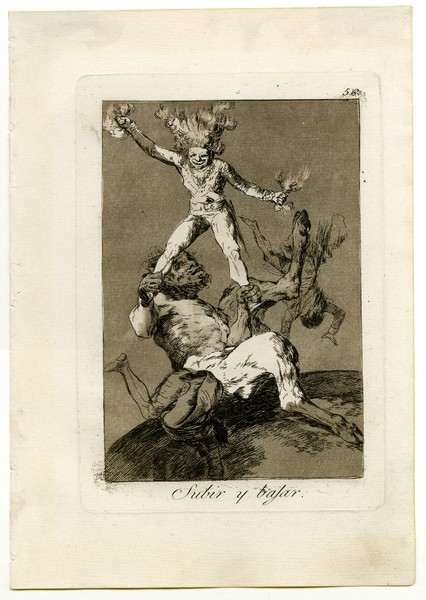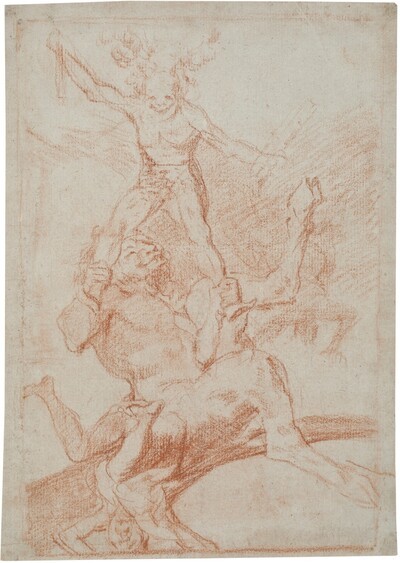- Cronología
- Ca. 1797 - 1799
- Dimensiones
- 217 x 152 mm
- Técnica y soporte
- Etching and burnished aquatint
- Reconocimiento de la autoría de Goya
- Undisputed work
- Ficha: realización/revisión
- 26 Dec 2010 / 29 May 2024
- Inventario
- 225
Subir y bajar. (at the bottom)
56. (in the upper right-hand corner)
See Francisco de Goya y Lucientes, Painter.
There is a state proof with burnished aquatint in the Bibliothèque Nationale de France in Paris.
A preparatory drawing of this engraving is in the Prado Museum.
A goat-legged satyr sitting on the globe lifts a figure dressed as a soldier into the air. He carries a sword at his belt, his legs are bare and smoke is rising from his head. From his hands, bolts of fire shoot out, which he hurls at his opponents around him, who fall into the void. They are those who were once exalted and are now overthrown by the new rising figure.
By using aquatint over the entire surface of the print, the painter has created a dark scene in which the losers fall. In addition, by using the varnish reserves, he has highlighted the white gleams on the personage on top and on the satyr who is lifting him up. The burnisher has been used in the smoke on the head and the fire in the hands.
This engraving is explained in Ayala's manuscript as follows: "Prince of Peace. Lust lifts him up by his feet; he fills his head with smoke and wind, and fires lightning bolts at his emulators (...)". In the Prado Museum's engraving no. 56, we are told the following: "Fortune treats those who give her as a gift very badly. It pays with smoke for the fatigue of climbing, and punishes those who have climbed by precipitating them". The one in the National Library states the following: "The Prince of Peace, lifted up by lust, and with his head full of smoke, vibrates lightning bolts against the good ministers. These fall and the ball rolls; which is the story of the favourites".
All three manuscripts agree that this is an allusion to Manuel Godoy (Badajoz, 1767-Paris, 1851), who came to power partly because he was the lover of Queen Maria Luisa of Parma (Parma, 1751-Rome, 1819). Godoy gradually removed from office many of the Enlightenment ministers, some of whom formed part of Francisco de Goya's circle of friends, such as Gaspar Melchor de Jovellanos (Gijón, 1744-Vega, 1811), Francisco de Saavedra y Sangronis (Seville, 1746-Seville, 1819), José de Moñino y Redondo, Count of Floridablanca (Murcia, 1728-Seville, 1808) and Pedro Pablo Abarca de Bolea, the Count of Aranda (Siétamo, Huesca, 1719-Épila, 1798).
Beyond any specific allusion, the painter intended to capture in an allegorical manner the political instability in Spain, where political posts were ephemeral and some were replaced by others, sometimes for entirely futile reasons. In this way, it was not possible to take measures of any depth, nor to undertake reforms with a future perspective.
Edwin Palm, who has analysed this engraving from an iconographic point of view, believes that the figure in the foreground raising the fire-thrower is a clear allusion to Pan, the god of lust, as well as a reference to Spain itself. Etymologically, Hispania could be identified as the country of Pan. We would therefore be looking at the image of Spain which, in turn, would refer us to the lust of Queen María Luisa, infatuated with Manuel Godoy, who governed the destiny of the country at many times.
-
Goya. Gemälde Zeichnungen. Graphik. TapisserienKunsthalle BaselBasle1953from January 23th to April 12th 1953cat. 241
-
De grafiek van GoyaRijksmuseum RijksprentenkabinetAmsterdam1970from November 13th 1970 to January 17th 1971cat. 41
-
Goya. Das Zeitalter der Revolucionen. Kunst um 1800 (1980 – 1981)Hamburger KunsthalleHamburg1980cat. 37
-
Goya y el espíritu de la IlustraciónMuseo Nacional del PradoMadrid1988from October 6th to December 18th 1988. Exhibited also at Museum of Fine Arts, Boston, January 18th to March 26th 1989; The Metropolitan Museum of Art, Nueva York, May 9th to July 16th 1989, Madrid curator Manuela B. Mena Marqués, scientific directors Alfonso E. Pérez Sánchez and Eleanor A. Sayrecat. 56
-
Goya. La década de Los CaprichosMadrid1992organized by Real Academia de Bellas Artes de San Fernando sponsored by Fundación Central Hispano, Madrid, consultant editor Nigel Glendinnig. From October 26th 1992 to January 10th 1993cat. 171
-
Francisco de GoyaMuseo d'Arte ModernaLugano1996exhibition celebrated from September 22nd to November 17th.cat. 56, p.83
-
Francisco Goya. Sein leben im spiegel der graphik. Fuendetodos 1746-1828 Bordeaux. 1746-1996Galerie KornfeldBern1996from November 21st 1996 to January 1997cat. 62
-
Goya e la tradizione italianaFondazione Magnani RoccaMamiano di Traversetolo (Parma)2006consultant editors Fred Licht and Simona Tosini Pizzetti. From September 9th to December 3th 2006cat. 56, p.159
-
Goya. Opera graficaPinacoteca del Castello di San GiorgioLegnano2006exhibition celebrated from December 16th 2006 to April 1st 2007p.38
-
Goya e ItaliaMuseo de ZaragozaZaragoza2008organized by the Fundación Goya en Aragóna, consultant editor Joan Sureda Pons. From June 1st to September 15th 2008cat. 337
-
Goya et la modernitéPinacothèque de ParisParís2013from October 11st 2013 to March 16th 2014cat. 163
-
Goya: Order and disorderMuseum of Fine ArtsBoston2014cat. 235
-
London2015cat. 29
-
Madrid2017
-
Goya engravings and lithographs, vol. I y II.OxfordBruno Cassirer1964p.131, cat. 91
-
Goya's "Subir y Bajar": Pan and AmbitionStudies in RomanticismThe Graduate School, Boston University1964pp.177-185
-
Vie et ouvre de Francisco de GoyaParísOffice du livre1970p.182, cat. 563
-
Zu Goyas Capricho 56Aachener KunstblätterL. Schwann1971pp.20-27
-
Goya, la década de los caprichos: dibujos y aguafuertesMadridReal Academia de Bellas Artes de San Fernando1992pp.279-281, cat. 170-171
-
Goya. El capricho y la invención. Cuadros de gabinete, bocetos y miniaturasMadridMuseo del Prado1993p.46, fig. 19
-
Catálogo de las estampas de Goya en la Biblioteca NacionalMadridMinisterio de Educación y Cultura, Biblioteca Nacional1996p.103, cat. 145
-
El libro de los caprichos: dos siglos de interpretaciones (1799-1999). Catálogo de los dibujos, pruebas de estado, láminas de cobre y estampas de la primera ediciónMadridMuseo Nacional del Prado1999pp.294-297
-
ParísPinacoteca de París2013p. 228
-
Goya: Order & DisorderBostonMuseum of Fine Arts Boston Publications2014pp. 335-339
-
LondonThe Courtauld Gallery2015p. 138
-
Goya. In the Norton Simon MuseumPasadenaNorton Simon Museum2016pp. 42-75
-
ZaragozaGobierno de Aragón y Fundación Bancaria Ibercaja2017p. 205

